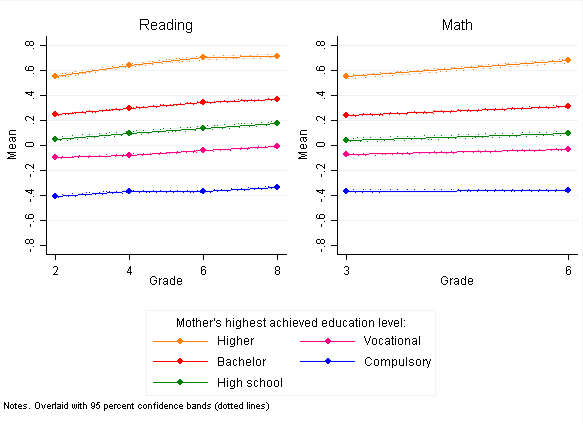Danish National Tests
Danish National Tests
What is the Danish National Test program? How do students perform on the national tests? This project documents socioeconomic inequality in students’ national test scores and discusses policy perspectives.
Time period: | 2010 - ongoing. |
Target group: | Danish public schools. |
Number of participants: | Approximately 50.000 students in each year, cohort, and test. |
Intervention: | The Danish national test program includes a reading test in the 2nd, 4th, 6th, and 8th grade, a math test in the 3rd and 6th grade, an English test in the 7th grade and tests in physics/chemistry, biology, and geography in the 8th grade. Tests are completed in the spring. The national tests are mandatory and completed online, in an adaptive test program maintained by the Danish ministry of Education. This ensures a systematic data collection, comparable across years. In addition, teachers may opt to test students in the Autumn prior to, or after, the mandatory test. This allows the teacher to follow each student’s progress through the school year. |
Research: | This project utilizes the complete set of students’ national test results 2010-2014. The project includes two main parts. The first part describes the format of the tests and the tests’ predictive validity in terms of exam grades in ninth grade. The second part provides descriptive analyses of the students’ tests results and the persistence of children’s national test scores throughout compulsory school. Data is combined with Danish register data on parental background to analyze achievement gaps in test scores. |
Results: | The national tests documents a socioeconomic gradient in student’s national test scores. The national tests documents negative and stable test score gaps of considerable magnitude for children with poorer socioeconomic backgrounds across all grade levels. For example, Figure 1 shows that children from families where the mother has obtained no more than compulsory schooling perform on average one quarter of a SD below children from families with vocational training, and more than one SD below families with higher tertiary education. These insights are important for school policies addressing social mobility at different stages of education. For an illustration, the Danish Co-teacher Experiment (insert link) find that a teaching assistant 14 lessons/week in sixth grade classrooms closes half of the achievement gap between students of low (blue line) and high (red line) educated parents in Figure 1. Figure 1. Achievement gaps in reading and math by mothers’ highest completed education level. Measured in standard deviation metrics. Figure 1. Achievement gaps in reading and math by mothers’ highest completed education level. Measured in standard deviation metrics.
|
Publications
Beuchert, L. V., Nandrup, A. B. (2016): The National tests at First Glance. Aarhus Universitet: Institut for Økonomi, Trygfondens Børneforskningscenter. (Under review – copy availably - please contact researchers)
Beuchert, L.V. and Nandrup, A.B. (2014): The Danish National Tests: A practical Guide. Aarhus Universitet: Institut for Økonomi, Trygfondens Børneforskningscenter.
Please contact the researchers (pr mail) if you want a copy of the figures.
